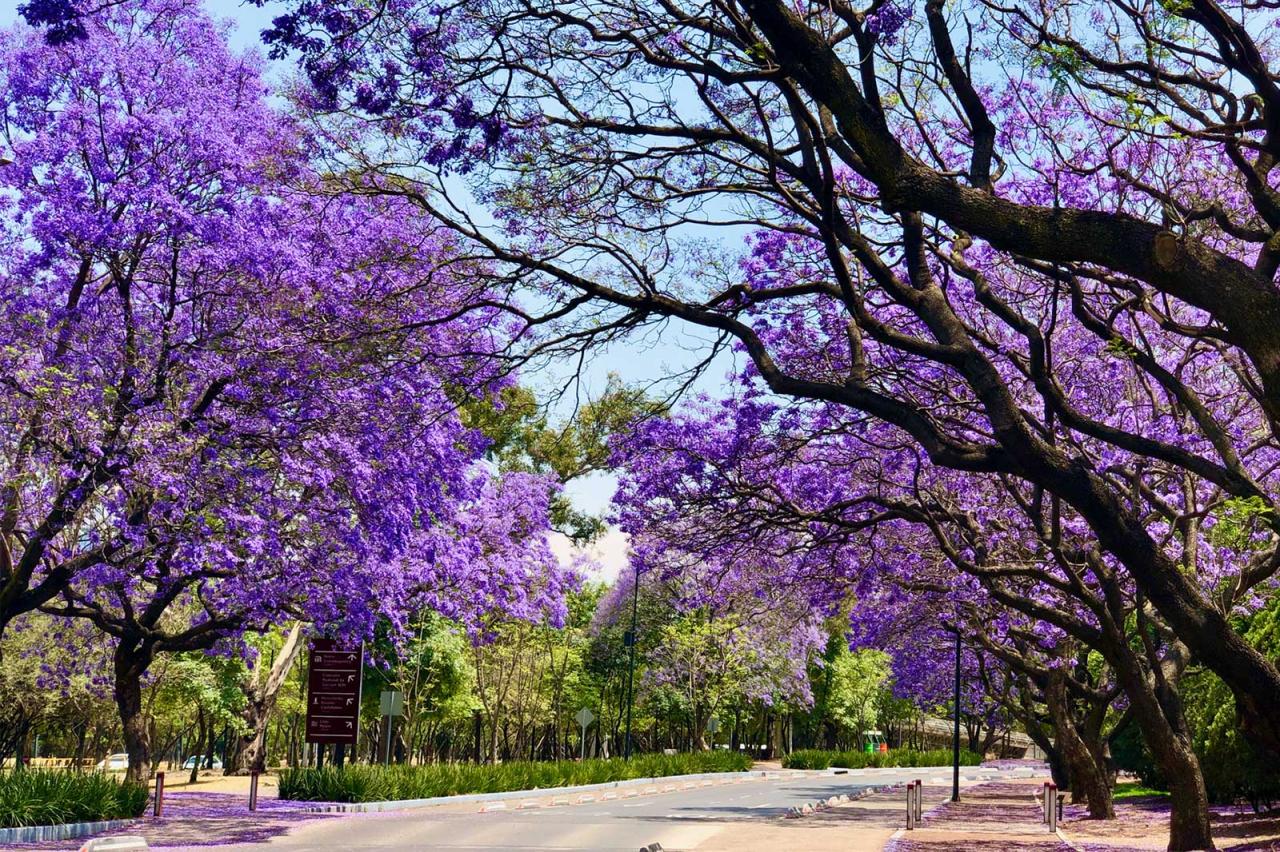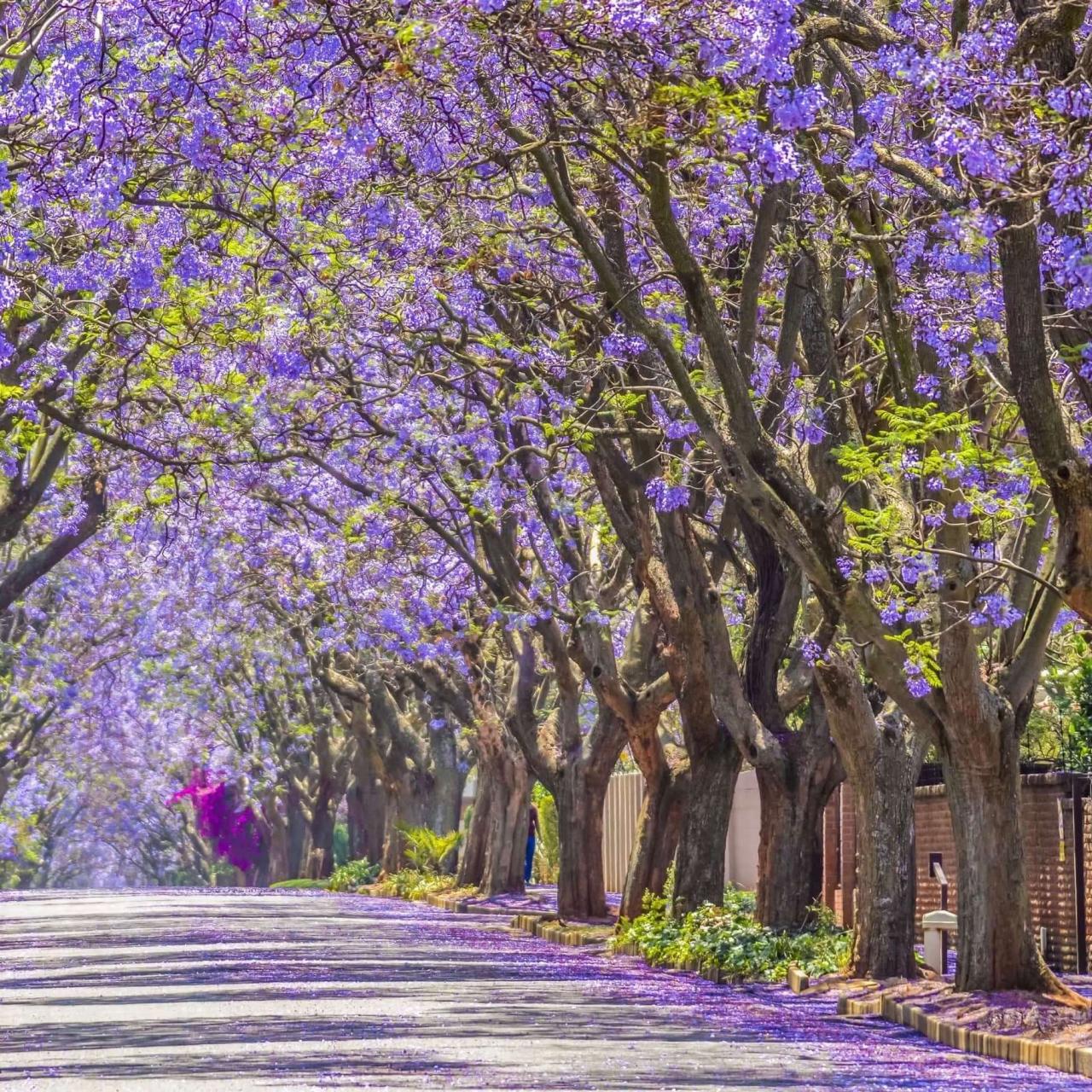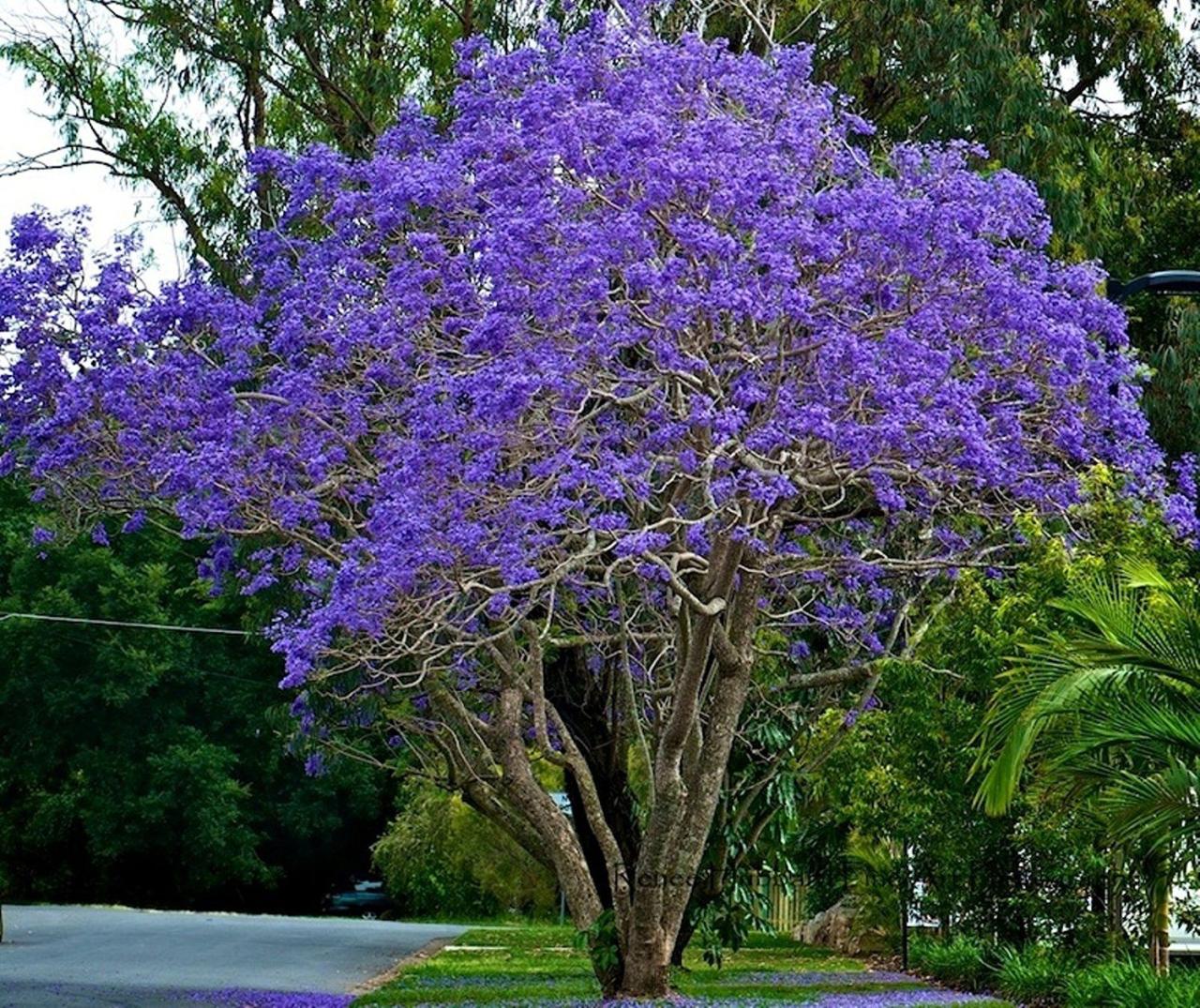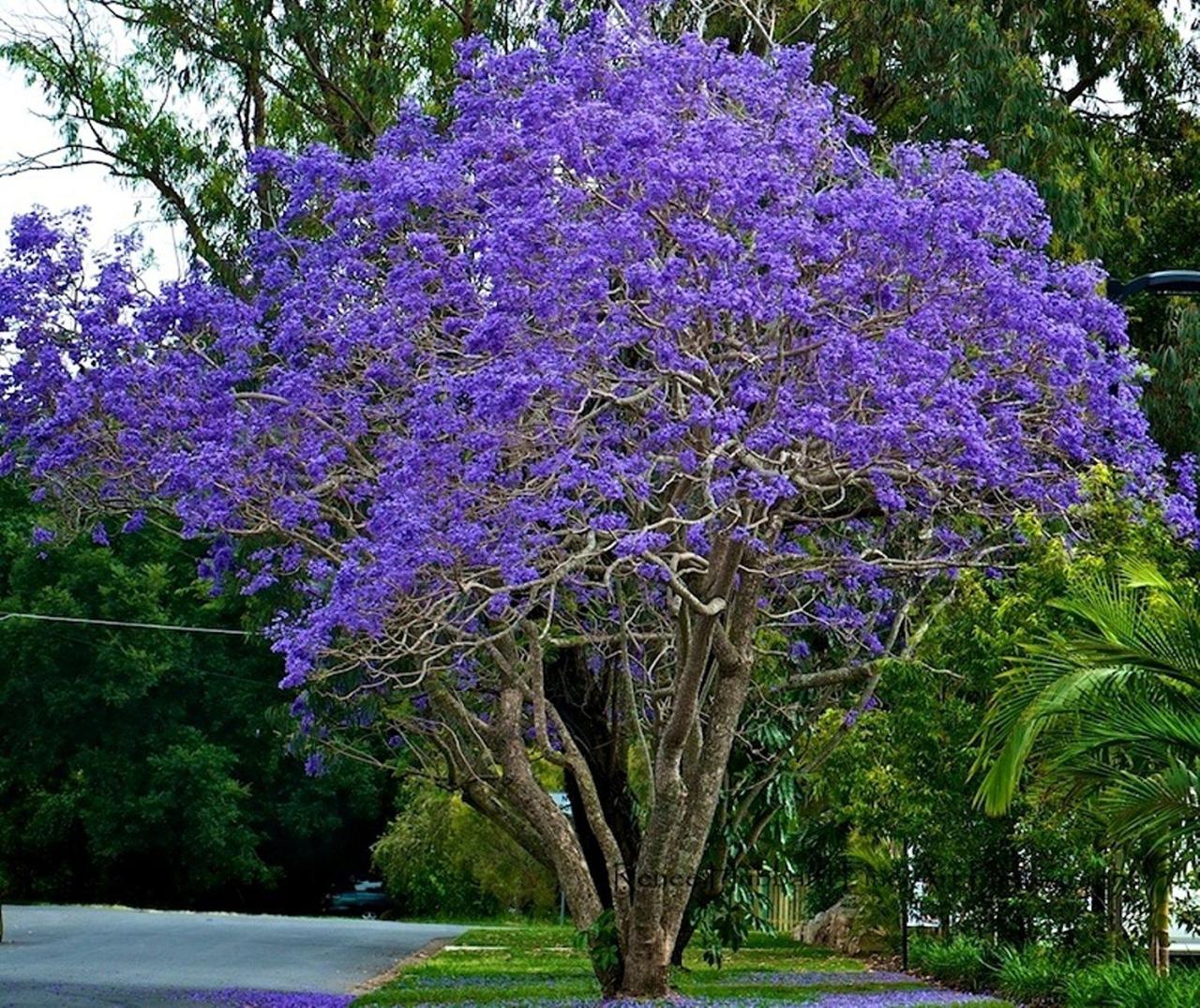How to Use Jacaranda Tree for a Unique and Elegant Garden Design: Expert Tips sets the stage for this enthralling narrative, offering readers a glimpse into a story that is rich in detail and brimming with originality from the outset.
Jacaranda trees, with their vibrant purple blooms and captivating presence, offer a unique opportunity to create a garden that is both stunning and unforgettable. This guide delves into the world of Jacaranda trees, providing expert advice on how to incorporate them into your garden design for a truly elegant and eye-catching landscape.
From understanding the ideal climate and soil conditions to selecting the perfect Jacaranda variety, this comprehensive resource equips you with the knowledge and tools to successfully cultivate these magnificent trees. We’ll explore the art of designing a garden layout that showcases the Jacaranda’s beauty, along with practical tips for planting, care, and creating a unique ambiance.
Whether you’re envisioning a serene garden path leading to a majestic Jacaranda or a vibrant tapestry of colors and textures, this guide provides the inspiration and expertise to make your dream a reality.
Introduction to Jacaranda Trees
The Jacaranda tree, with its captivating beauty and vibrant purple blooms, is a beloved sight in many parts of the world. Its unique appeal lies in its stunning visual impact, transforming landscapes into breathtaking displays of color and elegance. These trees are not just visually stunning; they also offer a wealth of benefits, making them an excellent choice for enhancing the aesthetic appeal and biodiversity of any garden.
Origin, Growth Habits, and Blooming Season
Native to South America, Jacaranda trees are known for their rapid growth rate and graceful, spreading canopy. They typically reach heights of 40 to 60 feet, with a lifespan of 50 to 100 years. Jacaranda trees are deciduous, shedding their leaves during the winter months in temperate climates.
However, their most spectacular feature is their blooming season, which occurs during the spring and summer months, depending on the region. During this time, the trees are adorned with clusters of vibrant, trumpet-shaped flowers that create a mesmerizing purple haze.
A Compelling Anecdote about Jacaranda Trees
The city of Pretoria, South Africa, is affectionately known as the “Jacaranda City” due to the abundance of these trees lining its streets. During the blooming season, the city transforms into a sea of purple, creating a truly enchanting spectacle.
“The Jacaranda trees are a symbol of Pretoria, and their blooms are a reminder that beauty can be found in the most unexpected places.”
Anonymous
Planning Your Garden Design
Jacaranda trees, with their vibrant purple blooms, can transform your garden into a breathtaking oasis. However, achieving the desired effect requires careful planning to ensure the tree thrives and complements your existing garden landscape.
Ideal Climate and Soil Conditions
Jacaranda trees are native to tropical and subtropical regions and prefer warm, sunny climates. They thrive in well-drained soil that is slightly acidic to neutral. Here’s a breakdown of their ideal growing conditions:
- Climate:Jacarandas flourish in USDA hardiness zones 9 to 11, where temperatures rarely drop below 20°F (-6.7°C). They are sensitive to frost and may experience leaf drop or damage in colder climates.
- Sunlight:Jacaranda trees need at least 6 hours of direct sunlight daily for optimal growth and flowering.
- Soil:They prefer sandy loam or clay loam with good drainage. Avoid planting them in heavy clay soils, which can lead to root rot.
- Water:While Jacaranda trees are drought-tolerant once established, they require regular watering, especially during the first few years after planting.
Garden Layout for Showcasing the Jacaranda’s Beauty, How to Use Jacaranda Tree for a Unique and Elegant Garden Design: Expert Tips
The jacaranda’s stunning purple blooms are a focal point for any garden. Strategic placement and thoughtful design choices can maximize their visual impact.
While planning your garden, consider the Jacaranda tree, a stunning addition with its vibrant purple blooms. However, don’t forget about the culinary world! For a unique twist on your dishes, explore the fragrant and flavorful Perilla leaf, Discover the Culinary Benefits of Perilla Leaf: How to Add This Herb to Your Cooking.
Back in your garden, the Jacaranda tree can be the centerpiece of your design, creating a breathtaking focal point with its cascading blossoms.
Jacaranda Placement |
Companion Plants |
Garden Features |
Design Tips |
|---|---|---|---|
As a centerpiece: Plant the Jacaranda in the center of your garden, allowing its cascading purple blooms to dominate the landscape. |
Low-growing plants: Use colorful annuals like petunias, zinnias, or marigolds to create a vibrant contrast against the Jacaranda’s purple blooms. |
Water features: A pond or fountain can enhance the tranquil atmosphere and create a visually appealing contrast with the Jacaranda’s vibrant blooms. |
Create visual flow: Use curved pathways or winding borders to lead visitors towards the Jacaranda, creating a sense of anticipation and wonder. |
Near a patio or seating area: Position the Jacaranda near a patio or seating area to create a shady retreat where you can enjoy its beauty up close. |
Vines: Climbing vines like bougainvillea or jasmine can add vertical interest and create a lush backdrop for the Jacaranda. |
Stone pathways: Stone pathways can create a sense of formality and elegance, complementing the Jacaranda’s majestic presence. |
Use contrasting colors: Plant companion plants with complementary colors like yellow, orange, or white to enhance the Jacaranda’s purple blooms. |
Along a driveway or border: Plant a row of Jacaranda trees along a driveway or border to create a dramatic entrance or a stunning visual effect. |
Grasses: Ornamental grasses like pampas grass or fountain grass can add texture and movement, complementing the Jacaranda’s delicate blooms. |
Outdoor lighting: Strategically placed outdoor lighting can illuminate the Jacaranda’s blooms at night, creating a magical ambiance. |
Consider scale: Jacaranda trees can grow quite large, so ensure you have ample space for their mature size. |
Planting and Care

Jacaranda trees are relatively easy to grow and maintain, but proper planting and care techniques are essential for their healthy growth and vibrant flowering. Here’s a comprehensive guide to ensure your Jacaranda thrives in your garden.
Jacaranda trees, with their vibrant purple blooms, can be a focal point for a stunning garden design. However, their beauty isn’t limited to the outdoors. If you want to bring a touch of the jacaranda’s elegance indoors, consider creating a garland of its delicate, fern-like leaves.
For inspiration on how to transform your indoor space with these gorgeous autumn leaf garlands, check out Transform Your Indoor Space with These Gorgeous Autumn Leaf Garland Ideas. Whether you choose to create a garland for a special occasion or simply to add a touch of nature to your home, the jacaranda’s graceful foliage will bring a touch of sophistication to any room.
Planting Jacaranda Trees
Planting Jacaranda trees is a simple process that involves selecting the right location and preparing the soil.
- Choose a sunny location: Jacaranda trees require full sun exposure for optimal growth and flowering. They need at least six hours of direct sunlight daily.
- Prepare the soil: Jacaranda trees prefer well-drained soil that is slightly acidic to neutral. Before planting, amend the soil with organic matter, such as compost or manure, to improve drainage and nutrient content.
- Dig a hole: The hole should be twice as wide and as deep as the root ball of the Jacaranda tree. This allows for proper root development and prevents root circling.
- Plant the tree: Gently place the tree in the hole, ensuring the root ball is level with the ground. Backfill the hole with the amended soil, gently tamping it down to remove air pockets.
- Water thoroughly: After planting, water the tree deeply to settle the soil and encourage root establishment.
Watering and Fertilizing
Watering and fertilizing are crucial for the health and vigor of Jacaranda trees.
- Watering: Jacaranda trees are drought-tolerant once established, but they benefit from regular watering, especially during the first year after planting and during periods of drought. Water deeply and infrequently, allowing the soil to dry slightly between waterings.
- Fertilizing: Jacaranda trees benefit from regular fertilization, especially during the growing season. Use a balanced fertilizer formulated for flowering trees. Apply fertilizer around the base of the tree, avoiding direct contact with the trunk.
Pruning Jacaranda Trees
Pruning Jacaranda trees is essential for maintaining their shape, promoting flowering, and removing dead or diseased branches.
- Timing: The best time to prune Jacaranda trees is after flowering, typically in late spring or early summer. Avoid pruning during the growing season, as this can inhibit flowering.
- Techniques: When pruning, use sharp, clean pruning shears or a saw. Make cuts just above a bud or branch junction, leaving a smooth, clean cut.
- Pruning for shape: Jacaranda trees naturally develop a rounded, vase-shaped form. To maintain this shape, prune any branches that are growing too long or out of control.
- Removing dead or diseased branches: Remove any dead, diseased, or damaged branches as soon as possible. This helps to prevent the spread of disease and maintain the tree’s health.
Pests and Diseases
Jacaranda trees are generally resistant to pests and diseases, but they can be susceptible to certain problems.
- Common pests: Some common pests that can affect Jacaranda trees include aphids, mealybugs, and scale. These pests can be controlled using insecticidal soap or horticultural oil.
- Common diseases: Jacaranda trees can be susceptible to diseases such as root rot, leaf spot, and powdery mildew. These diseases can be controlled using fungicides.
Creating a Unique and Elegant Ambiance: How To Use Jacaranda Tree For A Unique And Elegant Garden Design: Expert Tips

The Jacaranda tree’s striking purple blooms and graceful silhouette provide a natural foundation for a garden design that exudes both elegance and uniqueness. By strategically incorporating the Jacaranda into your landscape and selecting complementary elements, you can create a captivating and memorable garden space.
Designing a Garden Path Leading to a Prominent Jacaranda Tree
A well-designed garden path can draw attention to the Jacaranda tree and enhance the overall flow of the garden. Consider using natural materials like stone or gravel for the path, which complements the tree’s natural beauty and creates a sense of tranquility.
The path should gently curve towards the tree, leading visitors on a visual journey that culminates in a breathtaking view of the Jacaranda in full bloom. The path can be flanked by low-growing shrubs or flowering plants that add color and texture, further emphasizing the tree’s presence.
Complementary Garden Elements for a Unique and Elegant Ambiance
- Benches:Placing a bench or two near the Jacaranda tree provides a perfect spot to relax and enjoy the tree’s beauty. Choose benches made from materials like wood or wrought iron to complement the natural setting.
- Sculptures:A sculpture placed strategically near the Jacaranda can enhance the garden’s visual interest and create a focal point. Choose a sculpture that complements the tree’s style and color palette, perhaps a bronze sculpture or a stone carving that echoes the tree’s natural form.
- Water Features:Incorporating a water feature, such as a small fountain or a cascading stream, can add a soothing element to the garden and enhance the overall ambiance. The sound of water gently flowing can create a calming effect, further complementing the tranquility of the Jacaranda tree.
Creating Visual Contrast with Foliage and Flower Colors
To create a visually appealing contrast, consider planting foliage and flowers with contrasting colors and textures around the Jacaranda tree. For example, planting silvery-leaved shrubs or ferns near the Jacaranda will create a striking contrast against the purple blooms. Brightly colored flowers, such as red geraniums or yellow sunflowers, can also add a pop of color and create a vibrant contrast against the Jacaranda’s purple hues.
Jacaranda Tree Varieties

Jacaranda trees offer a range of varieties, each with its unique characteristics, making them ideal for different garden styles and preferences. Understanding these distinctions can help you choose the perfect Jacaranda variety for your garden.
Variety Comparison
Selecting the right Jacaranda variety is crucial for achieving your desired garden aesthetic. Here’s a comparison of some popular varieties:
Variety Name |
Key Features |
Growth Habits |
Ideal Garden Setting |
|---|---|---|---|
Jacaranda mimosifolia |
Widely cultivated, known for its vibrant purple blooms and feathery foliage. |
Rapid growth, reaching heights of 40-60 feet. |
Large gardens, parks, and avenues, where its dramatic canopy and stunning blooms can be appreciated. |
Jacaranda acutifolia |
Similar to J. mimosifolia but with a slightly smaller stature and more compact growth habit. |
Reaches heights of 30-40 feet, making it suitable for smaller gardens. |
Medium-sized gardens, courtyards, and patios, where its graceful form and vibrant blooms can be enjoyed. |
Jacaranda paucifolia |
Known as the “Black Jacaranda” for its dark, almost black, foliage and pale blue flowers. |
Smaller in size, typically reaching heights of 20-30 feet. |
Smaller gardens, rock gardens, and containers, where its unique color and compact size are appreciated. |
Jacaranda cuspidifolia |
Distinctive for its bright, golden-yellow flowers and larger leaves compared to other varieties. |
Reaches heights of 30-40 feet, with a spreading, rounded canopy. |
Gardens seeking a vibrant splash of color, particularly in areas with warm climates. |
Jacaranda Trees in Landscape Design
Jacaranda trees, with their captivating beauty and unique characteristics, are highly sought after for enhancing the aesthetic appeal of various landscapes. They are versatile and adaptable, making them suitable for diverse design projects, ranging from public spaces to private gardens.
This section will delve into the use of Jacaranda trees in landscape design, exploring their application in public spaces, parks, and residential gardens, along with examples of different landscape designs featuring these magnificent trees.
Jacaranda Trees in Public Spaces
Jacaranda trees are often chosen for public spaces due to their ability to create a visually stunning and welcoming atmosphere. They are frequently used to line streets, creating a canopy of purple blooms that transforms urban landscapes during their flowering season.
The trees’ cascading branches and vibrant flowers contribute to a sense of grandeur and sophistication, enhancing the overall aesthetic appeal of public spaces.
“Jacaranda trees are a symbol of beauty and resilience, making them ideal for public spaces where they can be enjoyed by everyone.”
Jacaranda Trees in Parks
Parks are ideal settings for Jacaranda trees, where they can provide shade, create a visually captivating focal point, and enhance the overall ambiance. They are often planted in groups or as solitary specimens, creating a sense of tranquility and serenity within the park.
Their vibrant purple blooms attract pollinators, contributing to the park’s biodiversity and ecological balance.
Jacaranda Trees in Residential Gardens
Jacaranda trees can add a touch of elegance and sophistication to residential gardens. They can be used as focal points, creating a striking visual impact, or as a backdrop for other plants and flowers. Their cascading branches and vibrant blooms can add a sense of grandeur and romance to the garden, making it a delightful space for relaxation and entertainment.
- Solitary Specimens:Jacaranda trees can be planted as solitary specimens in larger gardens, creating a dramatic focal point and enhancing the garden’s overall aesthetic appeal.
- Groupings:Planting Jacaranda trees in groups can create a sense of enclosure and privacy, making them ideal for creating intimate seating areas or pathways.
- Near Water Features:Jacaranda trees are often planted near water features, such as ponds or fountains, creating a serene and picturesque landscape.
Closing Summary
Transforming your garden into a breathtaking oasis with the help of Jacaranda trees is within your reach. By following these expert tips, you can create a landscape that is not only visually stunning but also provides a haven for relaxation and enjoyment.
Remember, a well-planned garden design that incorporates Jacaranda trees is an investment in beauty, serenity, and a touch of the exotic. So, embrace the captivating charm of these magnificent trees and let their presence elevate your garden to new heights of elegance and wonder.
FAQ Insights
What is the best time to plant a Jacaranda tree?
The ideal time to plant a Jacaranda tree is during the spring or early summer when the weather is warm and the soil is moist.
How often should I water a Jacaranda tree?
Water your Jacaranda tree deeply and regularly, especially during the first year after planting. Allow the soil to dry slightly between waterings.
Are Jacaranda trees susceptible to pests or diseases?
Jacaranda trees are generally pest-resistant, but they can be susceptible to diseases like root rot and fungal infections. Proper drainage and regular inspection are crucial for prevention.
